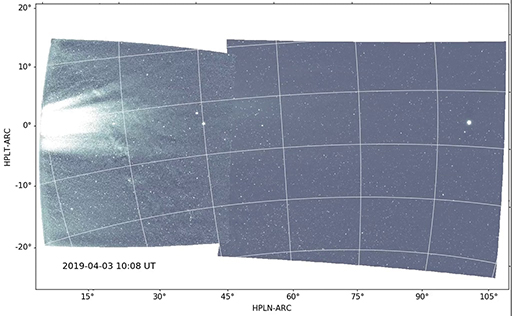Like an Afterburner
By Robert Frederick
Updating the theoretical model for the solar wind took years, new data, and kindness.
September 15, 2020
The Long View Astronomy Mathematics Astrophysics
It took four years before the scientific community accepted Gene Parker's mathematical description of the solar wind, the flow of charged particles emanating from our Sun that spread throughout our Solar System. That's when the world’s first interplanetary mission (NASA’s Mariner 2) gathered the necessary data to prove Parker right. Some 60 years later, NASA launched the Parker Solar Probe—its first mission named after a living person—to study what accelerates the solar wind. On the occasion, I spoke with Parker, who had met his namesake spacecraft and attended its launch (Parker, Meet Parker).
Many scientists looked forward to the data Parker Solar Probe would gather, including Bhimsen Shivamoggi, who was inspired by Parker to work on solar wind problems after meeting him a decade ago. Shivamoggi, a fluid and plasma physics theorist at the University of Central Florida in Orlando, labored for years to build on Parker's solar winds work. Just two months before mission scientists presented the Parker Solar Probe's initial findings, Shivamoggi submitted his latest research paper for publication. The probe's findings backed up Shivamoggi's theoretical model, which was shortly thereafter accepted for publication and selected as an Editor's Pick in the American Institute of Physics journal Physics of Plasmas. "I didn't even dream that the data would come out when it did," says Shivamoggi.

Among many findings from the mission scientists, the data also showed that the Sun's rotation had a much greater effect on the rotational speed of solar wind than was expected. According to one of the researchers' papers:
"These flows exceed classical velocity predictions of a few kilometers per second, challenging models of circulation in the corona and calling into question our understanding of how stars lose angular momentum and spin down as they age."
"Lucky for me," Shivamoggi says, "the data showed the solar wind co-rotation assumption in my model was really solid" and incorporated the higher-than-expected rotational wind velocity the scientists had just announced.
In one sense, nature has created a kind of stellar "rocket nozzle" through which it accelerates the solar wind, says Shivamoggi. In the typical rocket nozzle, subsonic acceleration of the gas going through the nozzle is driven by the nozzle's geometry. The supersonic acceleration is essentially driven by the gas's compressibility. "This was opposite of what happens with Parker's idea of a stellar rocket nozzle," says Shivamoggi, "it was a small point that he had not seen."
After convincing Parker of his point, and in considering making that correction, Shivamoggi also took on the larger problem of accounting for the Sun's rotation, which Parker had not incorporated at all. Shivamoggi found that the effects of the rotation of the Sun is akin to causing the throat of the rocket nozzle to narrow, enhancing the wind velocity like an afterburner and causing the star to lose angular momentum.
"Parker was so kind and he nourished me for 10 years," says Shivamoggi, "and then, over the past three to four years, I got to take a crack at the famous problem he worked on."
In the end, Shivamoggi says he surprised himself by ending up with a theoretical model that leads to an exact analytical solution, a relatively rare occurrence in modern physics in which a mathematical solution succinctly captures the entire physics of a problem unlike an approximate solution or, say, perturbative one. "That is a completely lucky thing," Shivamoggi says, "It doesn't happen often!"
Of course, Shivamoggi still had to make some assumptions and approximations in coming up with his theoretical model of the solar wind. After all, there's still a lot we just don't yet know about our Sun. But among the many instruments studying our Sun, the Parker Solar Probe also will be getting closer and closer to the Sun as its mission continues. Shivamoggi is already considering updates to his theoretical model so that it will better match the quantitative data that's coming in.
American Scientist Comments and Discussion
To discuss our articles or comment on them, please share them and tag American Scientist on social media platforms. Here are links to our profiles on Twitter, Facebook, and LinkedIn.
If we re-share your post, we will moderate comments/discussion following our comments policy.